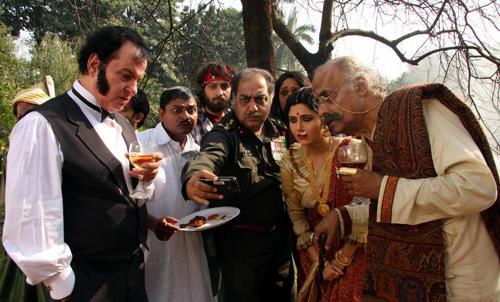 NIL
NIL
Back with a bang
Bengali films once set a benchmark for both good family dramas and serious cinema. Then for a few decades it faltered, putting off the knowledgeable audience. But now in its new avatar, it is bouncing back again, writes Moyna Sen
With the recent death of Suchitra Sen, the iconic romantic heroine of Bengali films, her best celluloid partner Uttam Kumar had left some decades ago, Bengali cine-goers moaned once again about the long-gone Golden Age of Bengali commercial films. But has it become a cliché to say that the days of Bengali movies is a thing of the past?
The recent scenario does not prove so. True, the hub of Bengali movies, Tollygunge was down in the dumps for a few decades. Most of the movies churned out were either pathetic remakes or simply pathetic. And this, despite Prosenjit Chatterjee, son of past matinee idol Biswajit, being reinstated as the only successor to the legendary Uttam Kumar. But the urban, educated cinemagoer had given up on the dismal fare called Bengali cinema.
But today Bengali movies are once again drawing the audience to the hall. A new crop of good filmmakers willing to experiment and take risks have entered the arena with fresh ideas and enterprise, and the effort is paying back big time.
Commercial Bengali movies had hit a nadir, till filmmakers like late Rituparno Ghosh and Satyajit Ray’s son Sandip Ray injected creativity with movies that made you sit up. Ghosh’s Chokher Bali (A Passion Play in English which when literally translated means sand in the eye) with Aishwaraya Rai (2003), in fact, was one of the biggest grossers of that time and is said to have been a turning point in introducing the corporate culture in Bengali movies. Shree Venkatesh Films, the producer, has carved a permanent place for itself in the Bengali film industry from then on.
Gautam Ghosh’s National Award winner Moner Manush (The Quest) and Aparna Sen’s latest Goynar Baksho (The Jewellery Box) have been big grossers in recent times too. However, directors like Ghosh and Sen, though established ones, were seen as essentially targeting a niche audience.
Joining the brigade now are filmmakers of a new genre, who are not only making movies that interest of the intelligentsia but are also keep a keen eye on the box office. It is obvious that the audience is thoroughly enjoying this new kind of cinema, with different themes and a whole new treatment. These films often have something serious to tell but narrated in such away as to keep the interest alive. Films like Ichhe (Wish) by Shiboprasad Mukherjee and Nandita Ray, about a mother who is obsessed with her son’s academic progress and has everything mapped out for his career leads to disastrous consequences. The theme could well be echoed in other parts of India with the middle-class obsession with academic performance.
Aniruddha Roy Choudhury is yet another filmmaker who burst into the scene with movies like Anuranon (Resonance) and thereafter his National Award winner Antaheen (The Endless Wait) in 2010 with the contemporary theme of love in the virtual world. The fresh look and excellent cinematography held out new hope for the Bengali audience. His third movie, Aparajita Tumi, set in America roped in the NRI crowd as well, thus injecting fresh business prospects for the industry.
Interestingly, the Bengali audience abroad has now suddenly woken up to contemporary Bengali movies, as was also evident with Anjan Dutt’s The Bong Connection. The eclectic music, the modern look and a language that is liberally peppered with the everyday English of a city dweller, endeared the films to the Bengali diaspora, who now find themselves being reflected in movies made in Bengal.
When debutante director Srijit Mukherji’s Autograph (2010) on a matinee idol’s obsession to remain at the top, insecurity and isolation turned out to be a resounding success, Tollygunge had a new language which brought in the people to the hall in droves. His second movie, Baishe Srabon, a whodunit with a difference, did not disappoint either. After a long hiatus, people started waiting for Bengali movies to release after being teased by promos.
A veteran award-winning ad filmmaker and a debutante diector Anik Dutta took the box office by storm with his maiden venture, Bhooter Bhobishyot (2012) imaginatively mixing the past (with ghosts) and present which is now being remade into Hindi by Satish Kaushik (Gang of Ghosts) signaling a trend perhaps of a reverse flow. Dutta feels that even the present crop of Bengali commercial filmmakers are luring back the audience. “Movies like Paglu and Awaaraare also hits in the city and are attractive because of their exotic foreign locales, till now only seen in Hindi movies, combined with good music and excellent photography,” he says, but confesses that he never imagined his film to set the cash register ringing the way it did.
In fact, when even outright commercial movies like Josh, Amanush and Dui Prithibi gross over Rs 5 crore, a significant rise in figures in the last few years, the signals are right for an industry trying to revive itself. Veteran directors and actors in the industry ascribe this to good content, fresh storylines and the ability of the new directors to read the urban audiences correctly.
The reputation of Bengali films catering to intelligent audience has not got a short shrift either. Once the home of so-called ‘parallel cinema’, it has witnessed a few new directors adding to that reputation. Kaushik Ganguly’s wonderfulShabdo is perhaps the first film made on Foley artistes, the sound wizards who make a film come alive; the biopicMeghe Dhaka Tara by Kamaleshwar Mukherjee is based on experimental filmmaker Ritwik Ghatak whose eponymous film title Mukherjee has adopted. As the connoisseurs wait for commercial release of Ganguly’s new film Apur Panchaliwhich takes off from Satyajit Ray’s path-breaking Pather Panchali (Ballad of the Road) and looks at the central character, child actor Apu as today, the excitement only reflects the rejuvination Tollywood is experiencing.
Unlike in the past, Bengali movies are also stretching their geographical boundaries. In the current box office hitChander Pahar (Mountain of the Moon) Kamaleshwar Mukherjee is taking a complete new path from the Ghatak biopic. Based on an adventure story written in 1937 by Bengal’s famous litterateur Bibhutibhushan Bandopadhyay Chander Pahar is shot in South Africa, with artists and technicians joining in from there. In fact, the country’s tourism department is targeting the Bengali tourist banking on the film’s popularity. Together with an emerging marketing strategy to appeal to the audience at home and abroad Tollywood is looking up again, indeed. Another golden age? Who knows?
Top Headlines
-
Entertainment
Valentyn Vasyanovychs To The Victory! wins 2025 TIFF Platform Award unanimously
September 26, 2025
-
Entertainment
Chlo Zhaos Hamnet Wins TIFF 2025 Peoples Choice Award
September 20, 2025
-
Entertainment
Sholay: Golden even after fifty years
July 04, 2025
-
Entertainment
War 2: Check out Hrithik Roshan, Jr NTR and Kiara Advani's new posters
June 26, 2025
-
Entertainment
LGBTQIA+: Icelandic film Odd Fish and Brazil's Baby win big at KASHISH 2025 film festival
June 12, 2025
-
Entertainment
Katrina Kaif named Maldives tourism global brand ambassador ahead of Modi's visit
June 10, 2025
-
Entertainment
'Queen marches to conquer': Deepika Padukone joins Atlee's AA22xA6 starring Allu Arjun after 'Spirit' exit
June 08, 2025
-
Entertainment
Dakota Johnson and Chris Martin, who were in on-and-off relationship, broke up: Reports
June 06, 2025
-
Entertainment
Sharmila Tagore to Alia Bhatt, India weaves cross-generational tale at Cannes 2025
May 28, 2025
-
Entertainment
Is Sandeep Reddy Vanga's cryptic 'feminism' post meant for Deepika Padukone? Neitzens think so
May 27, 2025


